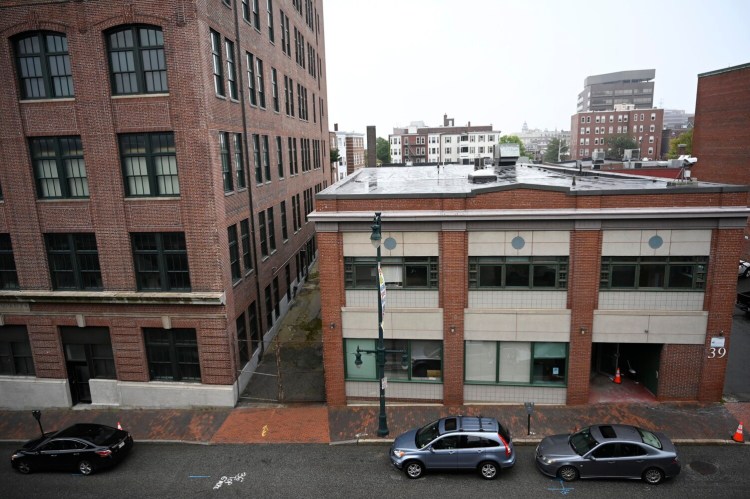A local developer is proposing to restore and convert a historic downtown Portland office building into 81 apartments, after a plan to use the space for a Maine College of Art & Design dormitory fell through.
The former New England Telephone Building at 45 Forest Ave., which is designated as a historic landmark, was originally eyed by the college for a new 180-student dorm. But school officials reconsidered those plans after the city decided to move its social services and public health offices, including its health clinic, next door.
Jonathan Culley, managing partner of Redfern Properties, which was working with the college on the dorm proposal, said he is now proposing a mix of studio and one-bedroom apartments for the site.
“(MECA&D) decided this location was not suitable for what they were trying to do, but we remain very positive about this location in the city,” Culley said, adding he’s comfortable with the city’s offices and health clinic next door. “We decided this is entirely compatible with the type of housing we want to build. There remains a real shortage of housing in Portland so we’re looking for every opportunity we can to build new housing.”
MECA&D released a strategic plan in late August that called for the creation of a living and learning center for students within walking distance of the college’s main building on Congress Street.
Last spring, the college announced that the Forest Avenue building fit its search criteria.
 But college officials expressed concerns about student safety after the city announced its plan to consolidate the city’s social services and public health offices at 39 Forest Ave. College officials noted that students can access the college’s art studios 24 hours a day – whenever inspiration strikes – and pointed out that 70 percent of the student body of roughly 500 students are young women.
But college officials expressed concerns about student safety after the city announced its plan to consolidate the city’s social services and public health offices at 39 Forest Ave. College officials noted that students can access the college’s art studios 24 hours a day – whenever inspiration strikes – and pointed out that 70 percent of the student body of roughly 500 students are young women.
Those concerns were criticized by students, who believed the college was purveying harmful stereotypes and not doing enough for current student safety.
Neither Beth Elicker, the college’s executive vice president, nor Leah Igo Brooks, the director of marketing and communications, responded to interview requests Thursday.
The city originally hoped to have the renovation completed by July, but City Hall spokesperson Jessica Grondin said the building renovations are not yet finished because of scheduling issues with contractors and other factors. The new space will house social services, including General Assistance, and public health programming, including the needle exchange, STD/HIV testing and the Portland Community Free Clinic, which provides health care to low-income people.
“We are solidifying moving dates, but nothing has moved into the building yet and construction is still ongoing,” Grondin said. “We are looking at possibly hosting a Zoom community update/Q&A about the move in the next few weeks, as we said we would during the approval process.”
The proposed apartments, which will be a mix of market rate and affordable, are generally between 400 and 600 square feet. The projected rents for the market rate units are between $1,300 and $1,800 a month, Culley said.
The project, consisting of 51 studios and 30 one-bedroom units, also will meet new inclusionary zoning requirements that were approved by voters in November.
Culley said 25 percent of the units will be affordable to people making up to 80 percent of the area median income, which ranges from $56,504 for a single person to $64,576 for a two-person household. Those units would rent for $1,198 for a studio and $1,398 for a one bedroom, he said.
Culley said he is able to meet the more stringent affordability requirements, but only because he is planning to use state and federal historic tax credits to help finance the roughly $15 million renovation.
“We haven’t been able to make it work in a new development,” he said.
Culley said the units would have 13-foot ceilings and large windows, and the building will have amenities, like a gym and a lounge for residents.
“They’re certainly on the smaller side, but what we’re finding is that in urban, walkable locations, people are willing to sacrifice size for location, convenience and amenities,” he said.
Send questions/comments to the editors.




Success. Please wait for the page to reload. If the page does not reload within 5 seconds, please refresh the page.
Enter your email and password to access comments.
Hi, to comment on stories you must . This profile is in addition to your subscription and website login.
Already have a commenting profile? .
Invalid username/password.
Please check your email to confirm and complete your registration.
Only subscribers are eligible to post comments. Please subscribe or login first for digital access. Here’s why.
Use the form below to reset your password. When you've submitted your account email, we will send an email with a reset code.